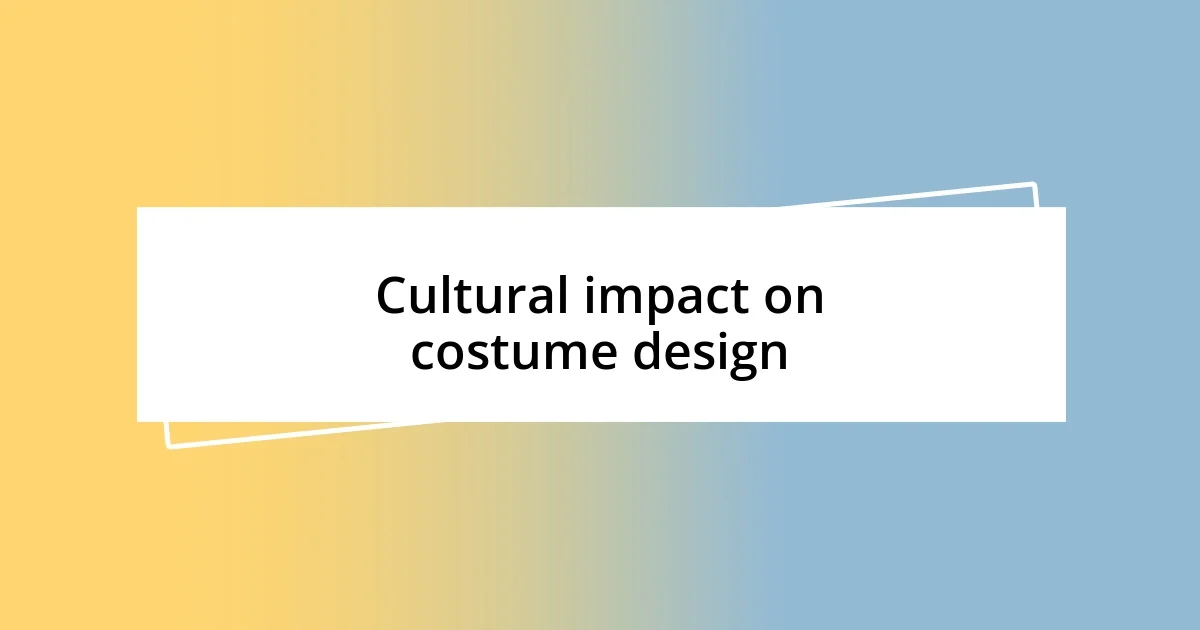Key takeaways:
- Costume design is deeply influenced by sociopolitical, cultural, and artistic movements, reflecting the values and sentiments of the respective eras.
- Technological advancements, from synthetic fabrics to 3D printing, have revolutionized costume creation, enabling greater creativity and sustainability.
- Modern trends in costume design emphasize inclusivity, body positivity, and environmental consciousness, making the craft more representative and eco-friendly.

Understanding costume design history
Costume design history is a fascinating tapestry woven from the threads of culture, politics, and human expression. I often find myself reflecting on how the costumes of different eras not only captured the zeitgeist but also mirrored societal norms. Have you ever paused to consider how the flapper dresses of the 1920s represented a bold move toward liberation for women, challenging traditional boundaries?
As I dive into various periods, I’ve noticed that each costume choice tells a story. For instance, the extravagant gowns of the Victorian era were as much about status as they were about fashion. I can’t help but feel a sense of awe when studying these garments, imagining the conversations and secrets that unfolded while they were worn. Doesn’t it spark curiosity to think about what those clothing pieces would say if they could talk?
In my experience, the evolution of costume design parallels advancements in technology and materials. Take the introduction of synthetic fabrics in the mid-20th century; it revolutionized costume possibilities. I remember being inspired while working on a project that utilized these new materials, making it feel like the future of design was within reach. Isn’t it amazing how innovation continues to shape what we wear and how we express ourselves?

Key influences on costume design
Costume design has always been influenced by the sociopolitical landscape of its time. I recall a time while I was researching the costumes from the World War II era and how they reflected not just practicality but also the prevailing sentiments of resilience and sacrifice. It’s fascinating to realize how designers used simple yet effective elements to convey powerful messages, don’t you think?
Another significant influence comes from popular culture and media. I remember being captivated by the iconic costumes in films like “The Wizard of Oz.” Each character’s attire didn’t just enhance their personality; it set the tone for the entire movie experience. Analyzing these choices allowed me to appreciate the relationship between costume design and storytelling in a deeper way. Have you ever considered how modern films still carry this legacy forward?
Finally, cultural movements and artistic movements have played pivotal roles in reshaping costume aesthetics. I often think about how the punk movement of the ’70s broke fashion norms with striking individuality. I felt a rush of excitement when I experimented with those influences while designing for a theatrical performance. It’s incredible how such audacity in costume design can capture the spirit of rebellion, isn’t it?
| Key Influence | Description |
|---|---|
| Sociopolitical Landscape | Influences design choices reflecting political and social sentiments of the era. |
| Popular Culture | Film and media impact costume aesthetics and character perception. |
| Cultural Movements | Artistic and cultural movements introduce bold new styles and concepts. |

Evolution of materials and techniques
As I explore the evolution of materials and techniques in costume design, I can’t help but marvel at how each innovation has transformed the crafting process. From the early days of handmade fabrics to the modern era of 3D printing, the evolution is compelling. I still remember the first time I experimented with digital fabric printing for a costume; seeing my designs come to life in such a vivid way felt like stepping into a new dimension of creativity.
- Natural Fibers: In the past, materials like cotton, wool, and silk were the staples of costume design, showcasing craftsmanship and natural beauty.
- Synthetic Fabrics: The introduction of polyester and nylon in the mid-20th century opened doors to more versatile and affordable options, revolutionizing costume creation.
- Tech Innovations: Tools like laser cutting and 3D printing have reshaped the design landscape, allowing for precision and uniqueness that’s exciting to explore.
- Sustainable Materials: Recently, there’s been a shift towards eco-friendly options, with designers experimenting with recycled and organic materials, which I find both refreshing and necessary.
Reflecting on these advancements, I think back to a project where I utilized repurposed materials to create an eco-conscious costume. The sheer thrill of breathing new life into discarded items was incredibly rewarding. It’s a testament to how our craft can evolve and adapt, ensuring that we not only embrace creativity but also contribute positively to the world around us.

Cultural impact on costume design
Cultural influences on costume design serve as a mirror reflecting society’s values and beliefs. I remember working on a project inspired by traditional Japanese garments, particularly kimonos, and how their patterns and colors conveyed deep meanings tied to nature and seasons. It’s intriguing to consider how these designs not only showcase artistry but also communicate rich cultural narratives, don’t you think?
The impact of ethnicity and heritage on costume design can’t be overstated. I once had the pleasure of collaborating with a costume designer who used textiles from her Indian background. Each piece we created was infused with vibrant colors and intricate embroidery, transforming our production into a visual tapestry of cultural storytelling. It made me realize that costumes aren’t merely fabric and thread; they hold stories that transcend generations.
As societies evolve, so do their representations in design. I still vividly recall the moment I attended a fashion exhibition focused on the LGBTQ+ community. The bold choices in costumes, particularly the extravagant outfits from drag culture, struck a chord with me. They showcased the power of self-expression and challenged traditional gender norms, emphasizing how costume design is, at its core, a celebration of identity and cultural diversity. Isn’t it powerful how fabric can give voice to such profound ideas?

Modern trends in costume design
Certainly! Here’s the section on modern trends in costume design, delivering a fresh perspective while keeping the tone conversational and engaging:
Costume design has increasingly leaned into the realm of technology, and it’s fascinating to witness this shift. I recently attended a workshop on augmented reality for costumes, where we used apps to visualize designs in real-time on actual performers. It was like something out of a sci-fi film! The ability to see how digital elements can blend seamlessly with physical garments opens up endless possibilities for storytelling through costume.
Moreover, inclusive design has become a pivotal focus. I recall a project where we aimed to create costumes catering to performers with different body types and abilities. Seeing the smiles on their faces as they wore outfits specifically tailored to empower them was profoundly moving. It made me realize that modern costume design isn’t just about aesthetics; it’s about celebrating individuality and ensuring everyone feels represented and beautiful on stage.
Sustainability is truly at the forefront of contemporary costume design trends, and I find it heartwarming. I remember participating in a community event where we swapped costumes instead of purchasing new ones. It highlighted the importance of reusing and recycling. There’s something magical about giving a costume a second life, ensuring that our designs not only dazzle but also honor our planet. Don’t you think it’s exciting to be part of a movement that prioritizes environmental consciousness in the creative process?














